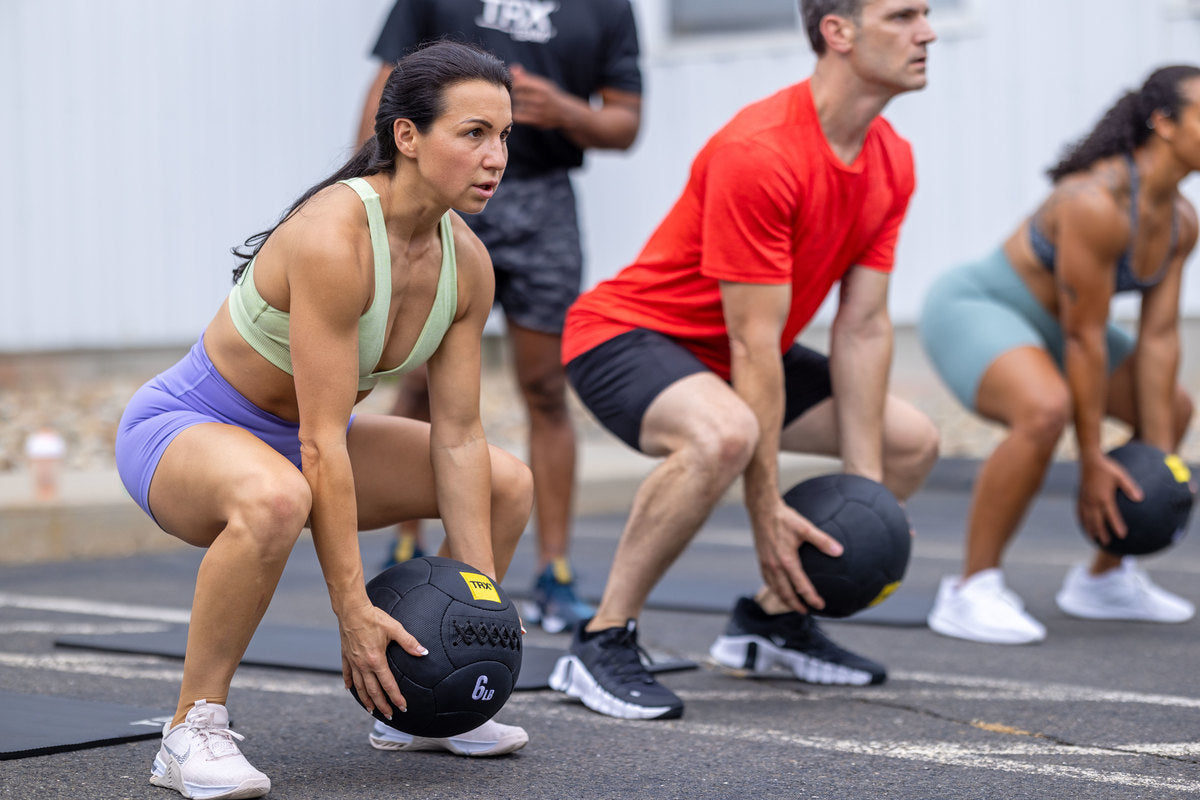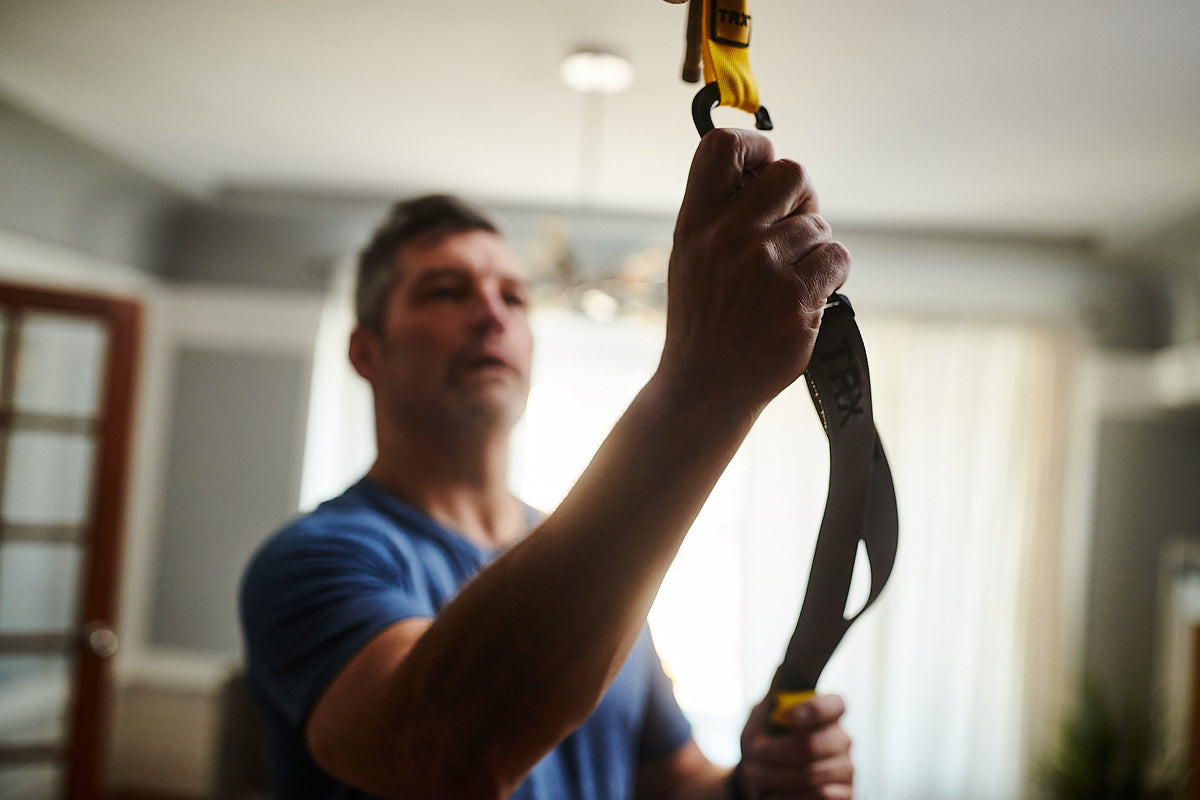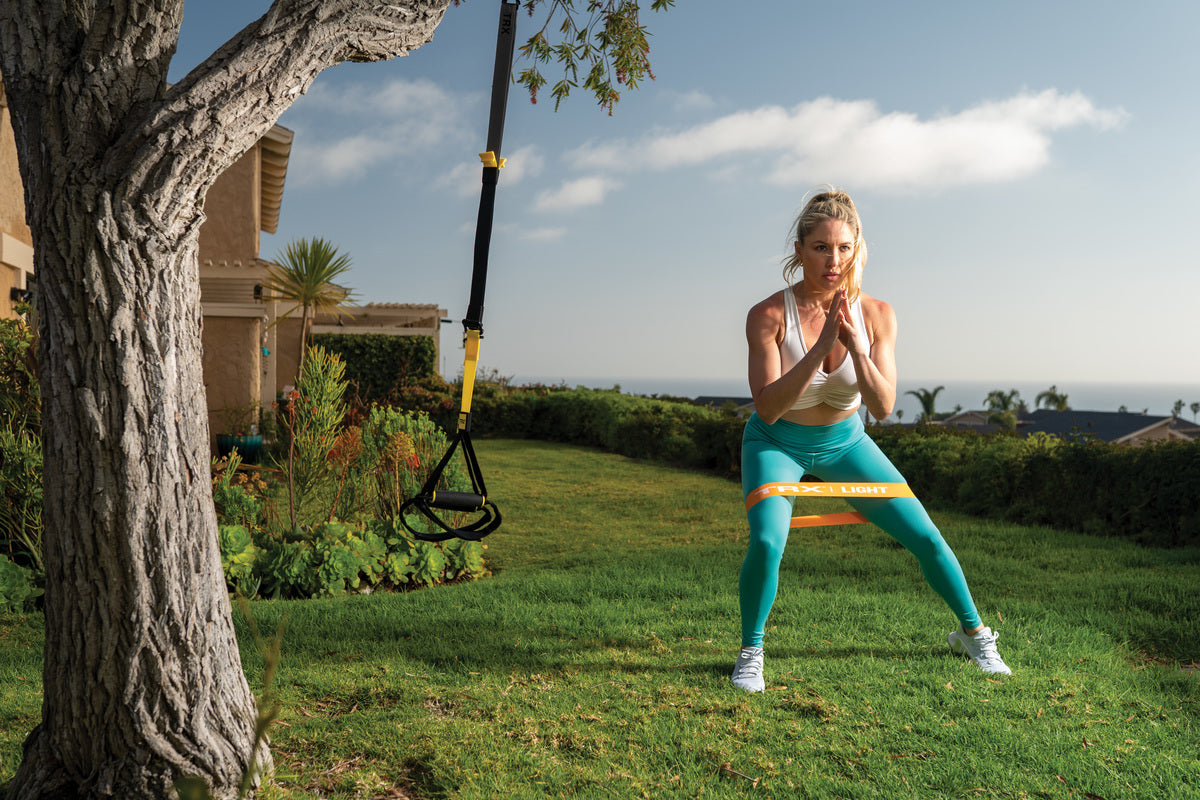Want more from your squat? Add a medicine ball and turn this lower-body staple into a full-body burner. By loading the movement with a medicine ball—and layering in TRX® Suspension Trainer™ variations—you’ll amplify core engagement, coordination, and power. This isn’t just about building stronger legs. It’s about unlocking strength you can use in real life.
Let’s break it down, rep by rep.
Benefits of Medicine Ball Squats
Medicine ball squats pack a serious punch. You’ll fire up your glutes, quads, hamstrings, and core while also getting your upper body in on the action. Holding a medicine ball challenges your posture and adds resistance, which means more muscle recruitment and more calories burned.
Now bring TRX gear into the mix.
Using a TRX Suspension Trainer™ gives you leverage to deepen your squats, improve alignment, and light up stabilizers that typical gym machines miss. Plus, the straps let you scale intensity without compromising form. Whether you're brand new to squatting or chasing your next PR, there's a progression for you.
Equipment You’ll Need
Start with:
-
A medicine ball (4–8 lbs for beginners, 10–20 lbs for advanced users)
-
A TRX Suspension Trainer™ anchored securely at mid-length
Not sure what size medicine ball you should get? If you're just starting out, go with a lighter option—around 4 to 8 lbs—to help you focus on proper form and control. As you build strength and confidence, you can gradually move up to heavier weights in the 10–20 lb range.
Want the best tool for the job? TRX Medicine Balls offer a grippy, textured surface and balanced weight distribution—designed to stay in your hands and out of your way.
How to Do a Basic Medicine Ball Squat
If you’re just getting started with medicine ball exercises for beginners, this basic squat is a great place to begin. It builds strength, improves form, and lays the foundation for more dynamic moves like throws or slams.
Step-by-Step Instructions
-
Stand tall, feet just wider than shoulder-width.
-
Hold the medicine ball at chest height, elbows tucked in.
-
Engage your core and keep your chest lifted.
-
Inhale as you lower into a squat—hips back, knees tracking over toes.
-
Go as low as you can with control (aim for thighs parallel to the floor).
-
Exhale and drive through your heels to return to standing.
-
Squeeze your glutes at the top.
Watch Out for These Form Fails
-
Knees collapsing inward
-
Heels lifting off the floor
-
Rounding your back or letting the ball drift forward
Pro tip: If depth is tough, elevate your heels slightly or use the TRX Suspension Trainer™ to help guide you into better mechanics.
Related: Try These 8 Medicine Ball Slam Alternatives
Medicine Ball Squat Variations to Try
Overhead Medicine Ball Squat
This dynamic full-body movement targets your lower body while demanding stability from your upper back, shoulders, and core. By holding the medicine ball overhead, you're not only working your legs and glutes through the squat but also activating your core and engaging your postural muscles to maintain balance and alignment. It’s an excellent way to build functional strength and improve total-body coordination.
How to do it:
-
Stand with your feet shoulder-width apart, holding a medicine ball with both hands.
-
Extend your arms fully, lifting the ball directly above your head. Keep your elbows close to your ears and engage your shoulders.
-
Tighten your abs to stabilize your spine and maintain an upright posture throughout the movement.
-
Push your hips back and bend your knees to squat down. Keep the medicine ball overhead the entire time. Make sure your knees track over your toes.
-
Hold the squat for a second or two, ensuring your back is straight and chest is up.
-
Press through your heels to return to the starting position while keeping the medicine ball overhead.
-
Perform 10–15 reps for 2–3 sets, or adjust based on your fitness level.
Medicine Ball Squat to Press
This powerful compound movement blends lower-body and upper-body strength training in one fluid motion. The squat portion activates your glutes, quads, and hamstrings, while the overhead press engages your shoulders, triceps, and upper chest. It’s a great functional exercise that boosts coordination, core stability, and overall power—perfect for building strength and efficiency in everyday movements.
How to do it:
-
Hold a medicine ball close to your chest with both hands, elbows tucked in.
-
Brace your abs to protect your spine and maintain a strong posture.
-
Push your hips back and bend your knees to lower into a squat. Keep the ball at chest height and your back straight.
-
As you rise back up from the squat, prepare to transition smoothly into the press.
-
As you reach the top of the movement, press the medicine ball straight up overhead until your arms are fully extended.
-
Lower the ball back to your chest with control, ready for the next rep.
-
Perform 10–15 reps for 2–3 sets, keeping the movement controlled and intentional.
Medicine Ball Squat Throw
This explosive exercise is one of the most effective types of medicine ball throws, blending strength and power in a single, dynamic movement. The squat engages your lower body, while the throw recruits your chest, shoulders, and arms. The quick, athletic motion improves coordination, builds explosive power, and elevates your heart rate for a cardio boost. It’s a great way to train for real-life movements that require both force and control.
How to do it:
-
Position yourself about 3–5 feet away, holding a medicine ball at chest level with both hands.
-
Keep your feet shoulder-width apart and engage your core for stability.
-
Push your hips back and bend your knees, keeping the ball close to your chest and your chest lifted.
-
As you rise from the squat, use your momentum to throw the ball forward against the wall. Aim for chest height.
-
Be ready to receive the ball as it bounces back. Catch it securely with both hands.
-
Immediately return to the squat position and go again.
-
Complete 2–3 sets, focusing on explosive power and smooth transitions.
TRX-Assisted Medicine Ball Squat
This variation combines the stability support of TRX with the added resistance of a medicine ball, making it perfect for improving form while still building strength. The TRX straps help guide your posture and balance, which is especially helpful if you’re working on squat depth or recovering from an injury. Adding the medicine ball increases resistance, activating your quads, glutes, and core for a well-rounded lower-body workout.
How to do it:
-
Stand facing the anchor point, holding a TRX handle in each hand.
-
Set your feet shoulder-width apart and stand tall. Hold a medicine ball close to your chest with both hands.
-
Keep your spine neutral and brace your core for stability.
-
Push your hips back and bend your knees, using the TRX straps for support and balance. Keep the ball at your chest.
-
Pause briefly at the bottom of the squat, making sure your knees are aligned and your back is straight.
-
Press through your heels to return to a standing position, keeping your grip on the straps light and controlled.
-
Complete 10–15 reps for 2–3 sets, focusing on smooth, controlled movement and proper alignment.
TRX + Medicine Ball Rotational Squat
This exercise adds a rotational twist to your traditional squat, challenging your balance, core strength, and coordination all at once. Using the TRX for support allows you to maintain proper form while integrating a rotational movement that targets your obliques and shoulders. The addition of the medicine ball not only increases resistance but also enhances the rotational load, making this a dynamic move for building strength and improving functional mobility.
How to do it:
-
Stand sideways to the anchor point. Hold one TRX handle in your left hand and a medicine ball in your right hand.
-
Stand with feet shoulder-width apart, facing forward, and engage your core for stability.
-
Lower into a squat position, pushing your hips back and bending your knees. Keep the TRX handle steady for balance.
-
As you descend, rotate your torso toward the side holding the medicine ball (right side). Extend your right arm with the ball as you twist, reaching slightly outward.
-
As you rise from the squat, rotate your torso back to center and bring the ball back to your chest.
-
Perform the same motion with the TRX in your right hand and the medicine ball in your left.
-
Alternate sides for 10–12 reps per side, completing 2–3 total sets.
Related: How to do Medicine Ball Push Ups (With Form Guide)
Try This TRX + Medicine Ball Workout
Run this six-move circuit for a fast, functional full-body blast.
-
Basic Medicine Ball Squat: 12–15 reps
-
TRX-Assisted Medicine Ball Squat: 10–12 reps
-
Medicine Ball Squat to Press: 10–12 reps
-
TRX Row with Medicine Ball Squeeze: 10–12 reps (hold ball between forearms)
-
Overhead Medicine Ball Squats: 8–10 reps
-
Medicine Ball Squat Throws: 8–10 reps
Timing Tip:
Work for 45 seconds, rest for 15. Complete the full circuit, rest for 1 minute, and repeat 3 times.
Beginner: 30 seconds work, 30 seconds rest
Advanced: 60 seconds work, 15 seconds rest
Want more challenge? Increase reps, weight, or tempo. Just don’t trade form for intensity. Quality first.
Add a TRX Rip Trainer™ Twist
For a game-changing combo, try pairing the Rip Trainer™ with a medicine ball. Pull the Rip Trainer across your body, then follow with a diagonal squat and lift using the medicine ball.
What it’s good for: Rotational strength, anti-rotation control, and spine stability. Perfect for sports like golf, baseball, and tennis.
Progression and Safety Tips
-
Start light and earn your reps.
-
Adjust TRX straps: shorten for support, lengthen for difficulty.
-
Progress by adding load, increasing time under tension, or changing your stance.
-
Always warm up for 5–10 minutes and listen to your body.
-
Stop if you feel joint pain (not to be confused with good old-fashioned muscle fatigue).
Form > Load. The medicine ball should challenge you, not compromise your movement.
Start Doing Your Squats with Medicine Balls Today
Medicine ball squats are a functional training powerhouse. Add TRX gear, and they become a movement masterpiece. Whether you’re just getting started or fine-tuning elite-level strength, this combo helps you move better, grow stronger, and live longer—exactly what TRX was built for.
Now grab your gear and get to work.



